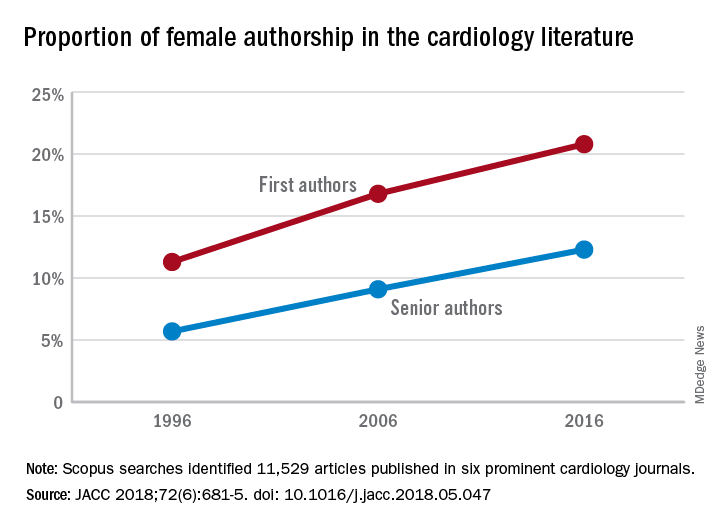and academic medicine overall, according to a review of content from six prominent cardiology journals.
The proportion of female first authors in the six journals – American Journal of Cardiology, Journal of the American College of Cardiology, BMJ Heart, European Heart Journal, Clinical Cardiology, and Circulation – rose from 11.3% in 1996 to 20.8% in 2016, an increase of 9.5 percentage points. Comparable numbers for female senior authors were 5.7% in 1996 and 12.3% in 2016, which works out to an increase of 6.6 percentage points, Mariam Asghar, MBBS, of Dow University of Health Sciences in Karachi, Pakistan, and associates reported in the Journal of the American College of Cardiology.
“The pervasive gender gap in cardiology has been a subject of concern,” they wrote. For academic medicine overall, 37% of first authors are female, and cardiology’s 20.8% is lower than such specialties as radiology (32%), ophthalmology (34%), and emergency medicine (24%), they noted.
The magnitude of the increase varied for each of the six journals over the 20-year period, with Clinical Cardiology having the largest gain for first authors (14.5 percentage points) and JACC the smallest (5.1 percentage points). The largest increase for female senior authors (11.6 points) came from Clinical Cardiology and BMJ Heart, while the smallest increase (2.4 points) was seen at the European Heart Journal, the investigators said.
Dr. Asghar and associates identified 11,529 articles in Scopus for all six journals for the 3 years in question (1996, 2006, and 2016), with sex of the first author determined for 9,749 and senior author for 11,411. Articles with only one author were credited as having a senior author.
The investigators reported having no relevant financial disclosures.
SOURCE: Asghar M et al. JACC 2018;72(6):681-5. doi: 10.1016/j.jacc.2018.05.047.


